Conflict Analysis Bulletin, Issue 13, January 2019, Focus on incidents in Palestinian camps in Lebanon


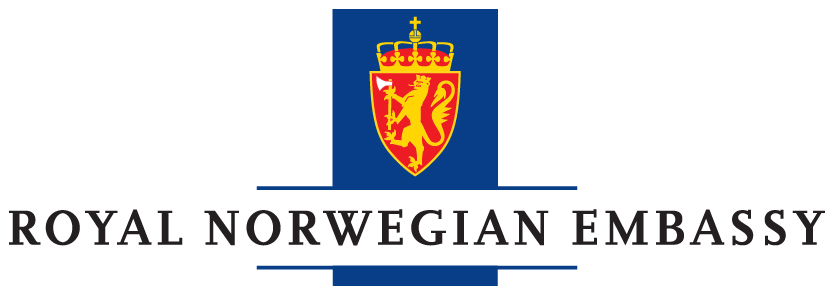
Issue 13, January 2019
*Scroll down for Arabic - للنشرة في اللغة العربية انظر(ي) إلى الاسفل
About the bulletin
The Conflict Analysis bulletin, part of the Conflict Analysis Project is an initiative by Lebanon Support, with the support of the United Nations Development Programme (UNDP), available on the Civil Society Knowledge Centre (CSKC), Lebanon Support’s knowledge platform. The Conflict Analysis Project aims to make available and accessible information and research about conflicts in Lebanon, in order to better understand their underlying causes, and inform interventions and policy-making.
This bulletin features visuals focusing on conflict trends mapped during the last third of 2018. It also highlights a selection of the latest publications on the project’s page, including papers, articles, reports, visuals, and interactive content.
Defining Conflict
Going beyond the view of conflict through a security framework associated with belligerency and violence, Lebanon Support upholds that conflict is of a socio-political nature. It thus sheds light on dynamics underlying a broad spectrum of violent and non-violent contentions including social movements, conflicts opposing minorities (ethnic, religious or sexual among others) as well as local, national or regional actors’ policies.
Read more on and visit the interactive conflict map here.
Main data trends from the September-December 2018 period:
- The last third of 2018 witnessed a total of 1093 which is a decrease of 12% compared to the second third of the year, and of 38% compared to the same period last year.
- Arrest was by far the most mapped first category during the last third of the year with 529 incidents which fell under this category. 42% of these incidents were relevant to illicit trade operations.
- The number of clashes (19) mapped between October and December more than tripled compared to the previous third of the year (6) with incidents often involving heavy artillery such as machine guns and grenades. 7 of them were located in the Palestinian camps of Mieh w Mieh which witnessed an escalation of tensions during the past months (see third visual below). The rest of the clashes were mainly located in the Bekaa region.
- Although the number of incidents classified as Individual Acts of Violence slightly decreased between October and December compared to the second third of the year, it remains the most mapped primary classification with 504 incidents under this classification.
- The number of incidents related to Border Conflicts with Syria (70 incidents) remain consistent compared to the previous third (69). They were mainly relevant to the arrest of Syrian nationals for illegal stay or for crossing borders illegally.
1. Overview of conflict incidents mapped (September-December 2018)
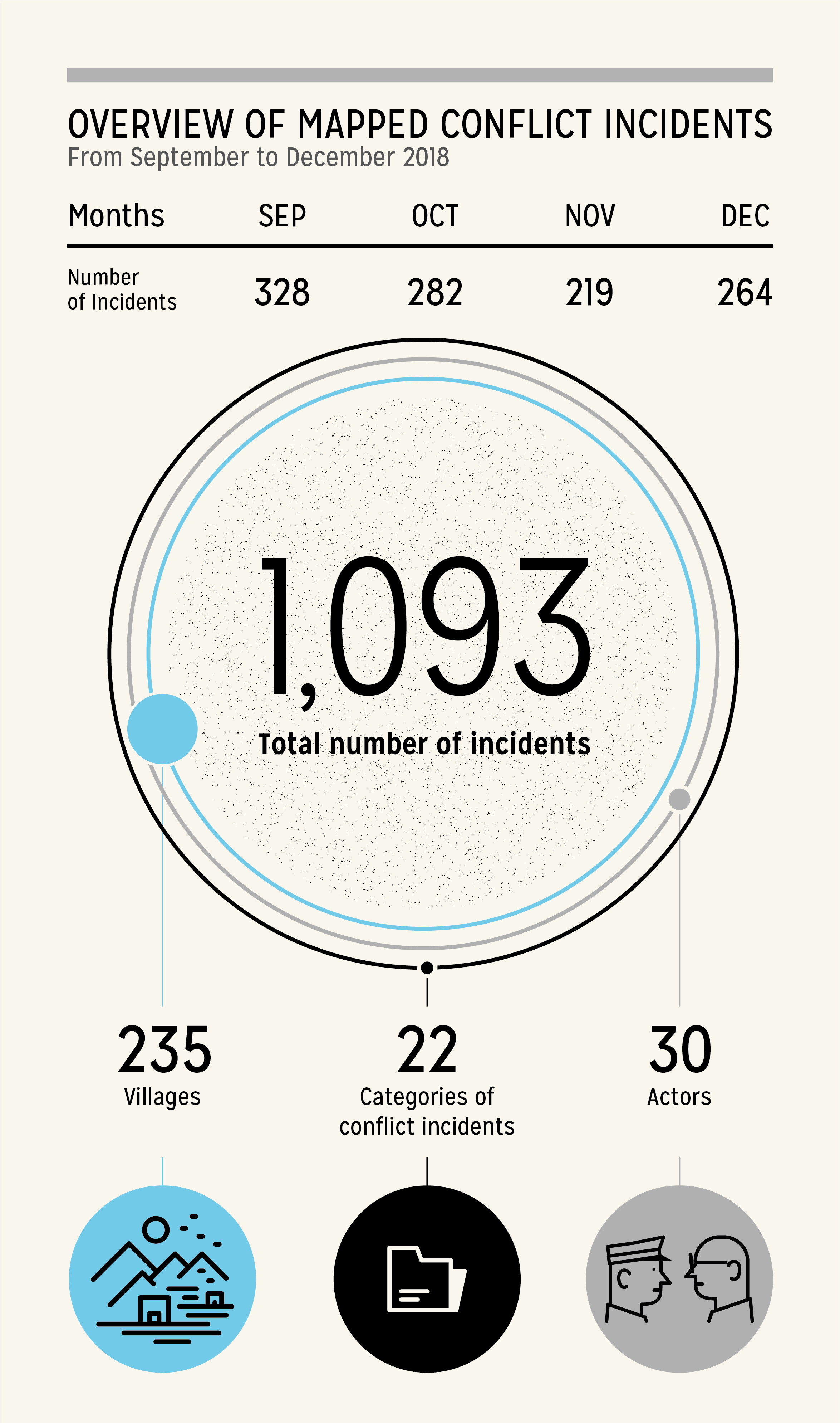
- Locations
The last third of 2018 witnessed a total of 1093 which is a decrease of 12% compared to the second third of the year, and of 38% compared to the same period last year. The mapped incidents were scattered across the country since incidents in the 5 most mapped cazas amounted to less than 37% of the total mapped incidents.
Sour, which only arrived in the third position during the previous third of the year became the most mapped location with 110 incidents mainly related to Israeli Borders Conflicts. It was followed by Saida (110), Beirut (106), Marjaayoun (68), and Baalbeck (64).
In Saida, the majority of the incidents (61) were classified as Individual Acts of Violence mostly relevant to arrests, brawl/disputes, shootings, robberies etc. Also, 27 incidents mapped in Saida were located in Ain el-Helweh. As a result of the precarious socio-economic conditions, the camp often witnesses a rise in tensions between factions, but also between refugees. (Read more on Ain el-Helweh on our Conflict Analysis bulletin, Issue 7 here).
67% of the incidents mapped in Beirut were categorised as arrest, This number indicates the notable security state presence in the capital, which is contrasted by a relative absence in their presence in the territory’s peripheries.
After witnessing a deterioration in the past months, the security situation in Baalbeck became more steady during the last third of the year, as the number of conflicts reported in the caza significantly dropped by 57% compared to previous third (157). This improvement of the security situation has been attributed to the intensification of the Lebanese Army’s operations in the area as well as the residents’ efforts to restore security. Indeed, as a result of poor development and state control, the region has been dominated by prominent clans, often backed by their own militia, and became a stronghold for criminals and fugitives. As such, beyond security concerns, LAF’s recent operations in the area could be seen as an attempt by the state to regain control of, and restore its authority in the region.
- Categories
Arrest was by far the most mapped first category during the last third of the year with no less than 529 incidents which fell under this category. 42% of these incidents were relevant to illicit trade operations.
Between October and December 2018, the number of incidents categorised as illicit trade (238) increased by 22% compared to the second third of the year (196). The majority of them were related to drugs (168), while 19, 16, and 14 incidents, involved respectively human smuggling, counterfeit money, and document forgery. Although Lebanon is one of the main cannabis producer in the world, this practice remains illegal in the country. However, in a context of public debates to legalise the production and exportation of medicinal cannabis, discussions have been ongoing within the newly elected Parliament to explore such a possibility. Still, despite this new political development regarding cannabis cultivation, authorities do not seem to have lessened their determination to eradicate drug trafficking in the country, as the number of operations related to drugs kept increasing during the last third of the year. (Read more on illicit trade operations on our Conflict Analysis bulletin, Issue 9, January 2018 here, and view the analysis of state response to illicit activities in 2015 here)
The number of clashes (19) mapped between October and December more than tripled compared to the previous third of the year (6) with incidents often involving heavy artillery such as machine guns and grenades. 7 of them were located in the Palestinian camps of Mieh w Mieh which witnessed an escalation of tensions during the past months (see third visual below). The rest of the clashes were mainly located in the Bekaa region and erupted during Army’s operations in the area to arrest wanted criminals. For instance on November 30th, an armed clashes took place between the LAF and prominent criminals who opened fire on the patrol during a raid operation causing several injuries. Indeed, the proliferation of weapons has been an ongoing issue in Lebanon for years. (Read more on shooting incidents in our Conflict Analysis bulletin, Issue 10, February 2018 here). In a context of instability and socio-economic tensions, the availability of weapons has allowed the formation of armed militias which operate outside of the state control. As a result, armed clashes often occur between state security apparatuses and well-armed militants, but also between armed militants affiliated to prominent families and clans.
38 collective actions have been mapped during the last third of the year. The grievances were diverse and were mostly related to ongoing issues such as corruption, waste management crisis, and socio-economic issues. It seemed that frustration among citizens has been growing during the past months, since the election of a new Parliament in last May, that corroborated existing confessional politics, the formation of a new government has been blocked due to political antagonisms and struggle for power between political parties. All of this has hampered attempts to reform and tackle major socio-economic issues in Lebanon, and added a pretext for possible mobilisations and future collective actions.
Incidents of gender-based violence increased by 40% between October and December, particularly with incidents related to domestic violence, sexual assault, as well as sextortion. Interpol International defines sextortion as “blackmail in which sexual information or images are used to extort sexual favours and/or money from the victim”. The Cyber-Police as well as civil society organisations such as the Social Media Exchange (SMEX) have been raising awareness against this issue. Despite these efforts, cases of sexual extortion remain common in Lebanon due to ignorance surrounding the issue and victims reluctance to denounce such crimes.
- Actors
Between October and December 2018, the Internal Security Forces (ISF) became the most mapped actor involved in 375 incidents, although it was only the third most mapped actors during the previous third (243 incidents). This significant increase suggests a proactive stance of the state security apparatuses to contain criminality during the reported period (see above). Lebanese civilians was the second most mapped actor involved in 370 incidents, followed by the Syrian civilians/refugees involved in 221 incidents, which is an increase of 16 compared to the second third of the year (190). These incidents were mainly related to arrest of Syrian nationals for illegal stay, or for committing infractions such as forgery, illicit trade, robbery, etc.
It is noteworthy to mention in this context, that the restrictive policies adopted by the Lebanese state as of October 2014 in order to control Syrian presence in Lebanon, have contributed to increasing informality amongst Syrian refugees, as well as the numbers of refugees lacking illegal papers, rendering them more vulnerable to arrest and detention. You can read more in-depth research on this topic here.
The number of incidents involving Palestinian civilians/refugees (77) was consistent with the trends of the previous third of the year (71) and were mainly located in Palestinian camps of Ain el-Helweh and Mieh w Mieh. It is noteworthy to point that even if the number of incidents involving Palestinian remained consistent, the scale of such conflicts was more important during the last four months of 2018, with the eruption of armed clashes, notably in Mieh w Mieh camp (see third visual below for more on clashes in Palestinian camps).
2. Frequency of incidents by primary classification of conflict (September- December 2018)
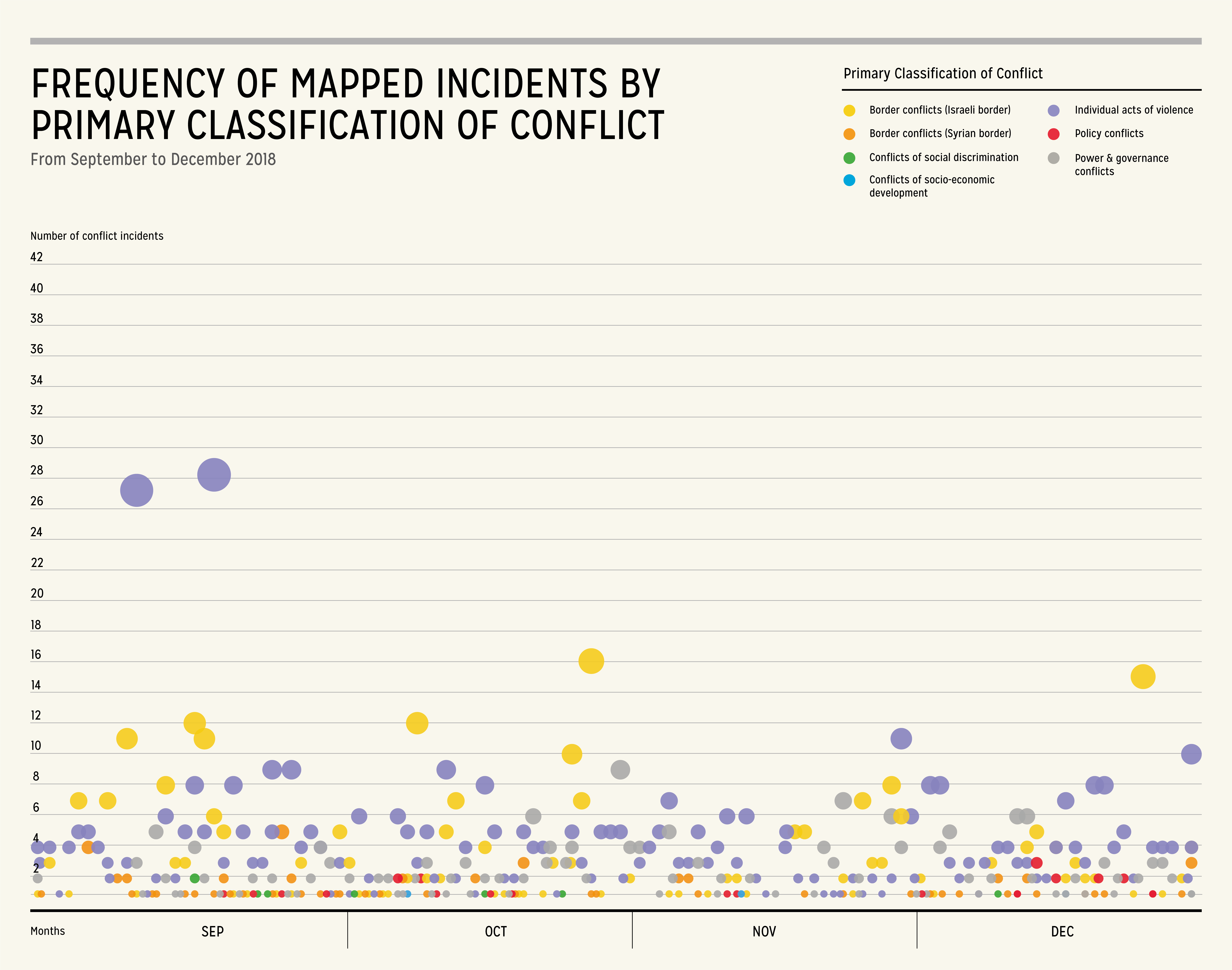
Although the number of incidents classified as Individual Acts of Violence slightly decreased between October and December compared to the second third of the year, it remains the most mapped primary classification with 504 incidents under this classification. Moreover, 203 incidents were classified as Power and Governance conflicts which is consistent with the previous third trend (199). This number indicates that, although Lebanon has witnessed recurring episodes of violence and tensions during the past years involving clashes, waves of suicide bombings, terrorist attacks, political tensions among other threats to its central state power, the majority of the reported security incidents in the country remain related to criminality and law infringements among citizens such as disputes, shootings, assaults, etc. The country’s stagnant socioeconomic situation may have likely contributed to the higher levels of criminality and law infringements as inequality remains high.
The number of incidents related to Border Conflicts with Syria (70 incidents) remain consistent compared to the previous third (69). Most of these are located within Lebanese-Syrian borders in Marjaayoun and Hasbaya. They were mainly relevant to the arrest of Syrian nationals for illegal stay or for crossing borders illegally. For instance, on September 27, LAF arrested over 200 Syrian nationals in Soueiri as they attempted to enter Lebanon illegally. During this operation gunfire were exchanged between the smugglers and the Army, leading to 4 casualties among the refugees.
Moreover, 3 of these incidents had a discriminatory nature, and were therefore classified as Conflicts of Social Discrimination with the Army conducting raids on Syrian refugees camps. Although these operations initially target wanted people who have sought refuge in the camps, the Army usually ends up arresting a significant number of refugees without legal papers. For example, on October 29th, the LAF arrested 121 refugees during a raid on a camp in Arsal, among which only 21 had existing warrants against them. This has led many to question the purpose of such raids operations.
15 Conflicts of Social Discrimination were mapped during this period. 4 of these incidents were related to gender-based violence with authorities dismantling prostitution rings. For instance, on October 18th, ISF arrested 4 members of a sex trafficking group in Marjaayoun. Most of the incidents related to prostitution involved Syrian women who were most of the time forced into this practice. The latter have been more vulnerable and exposed to sexual exploitation as they often do not have access to legal residency, which make them reluctant to denounce such crime (see our report on Syrian refugees’ livelihoods here and read the Conflict analysis bulletin, Issue 11, May 2018 here for more on gender-based violence related incidents).
Between October and December, 10 incidents were classified as Conflicts of Socio-Economic Development mainly relevant to collective actions organised by informal groups of citizens decrying the unsteady economic situation in the country but also by public workers groups who have been mobilising for years for an improvement of their socio-economic situation. For instance, public teachers have been mobilising, at least since 2011, demanding a raise of their salary scale. However discussions to increase their wages currently seem at an impasse. Despite the elections of a new Parliament on May 6th, the state has been unable to address citizens’ demands which have led to a rise of mobilisations during the last months of the year. The hope that the elections of a new Parliament would improve the socio-economic situation in the country seem to have faded among citizens who have been taking to the streets to pressure authorities to address their concerns before the end of the year. A recent paper published by Lebanon Support within the Civil Society Review, analyses the limits of the worker’s movement and its rather limited impact on reform.
3. Focus on incidents in Palestinian camps in Lebanon
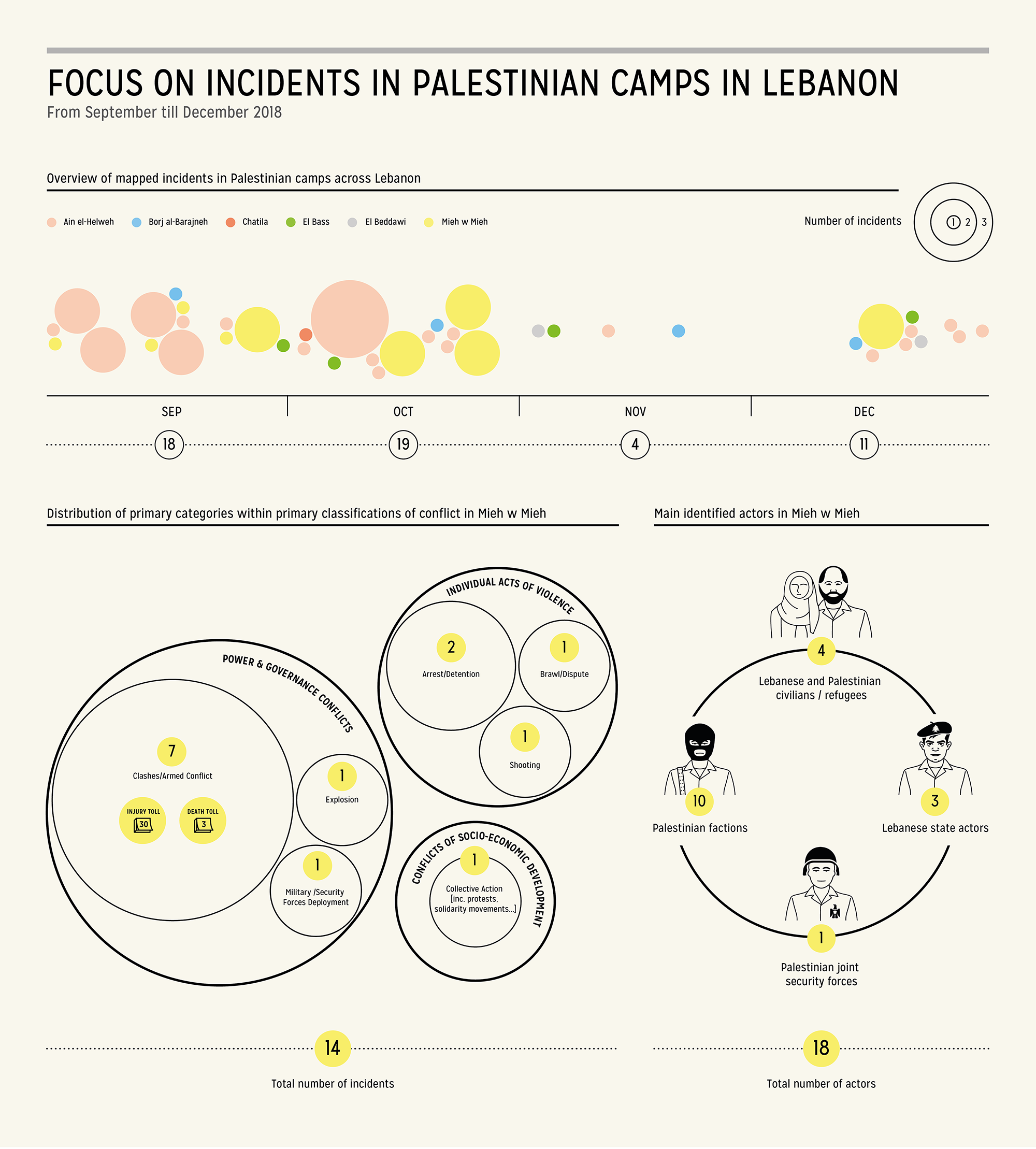
Lebanon currently has 12 Palestinian refugees camps, hosting approximately half a million registered refugees according to the United Nations Relief and Work Agency (UNRWA).
Although conflicts have been frequent in these camps for the past decades, with alternating periods of violence and relative calm, the last four months of the year witnessed a rise of tensions. In fact, a total of 52 incidents have been mapped in Palestinian camps across Lebanon in the span of only four months.
7 of them were related to armed clashes between Palestinian factions and were mapped in Mieh w Mieh camp. The latter is located in Saida and host over 5000 registered refugees. On October 16th, a clash broke out in the camp following an individual dispute between a Fatah and Ansar Allah members. The dispute quickly escalated into an armed conflict between both factions, which lasted for over a week and during which machines guns, grenades, and other heavy weapons were used.
There are over 17 factions operating within the camps with most of them being actively armed, and thus occasionally leading to the eruption of armed conflicts.
However, attributing the security instability in these camps to the presence of armed factions is quite reductive, as the emergence of conflicts is not exclusively associated to a rise of tensions between armed militants groups, but also to a rise of violence in general. Indeed, the socio-economic situation in the camps are extremely precarious with poor housing and services, lack of infrastructures, unemployment, among many other issues. This situation was exacerbated by the influx of Palestinians fleeing the Syrian war to camps with already limited access to resources. As such, the perpetual stress of life faced by the refugees often leads to outbreak of violence. This is corroborated by the data trends as the majority of the incidents mapped within the Palestinian camps are classified as Individual Acts of Violence (33) mainly related to shootings, disputes, illicit trade activities, etc.
In order to improve these living conditions, the UNRWA has been providing support and development aid to the Palestinian population including health care, education, and other social services, since its establishment on 1949. However, for the past months, the agency has been facing its “greatest financial crisis”. On August 31st, the United States (US) announced its decision to stop all donations to the agency, several months after it first started cutting funds. As the US represented the agency’s largest contributor, the decision engendered significant repercussions on the UNRWA’s operations. As such, many experts fear the humanitarian consequences of such crisis on the Palestinian population who are highly reliant on the agency’s aid. Indeed, this crisis risks to deteriorate the already precarious living conditions, making the camps more vulnerable to the resurgence of violence and conflicts.
4. Featured mapping within the Conflict Analysis Project
The Conflictivity Index maps for the first half of 2018
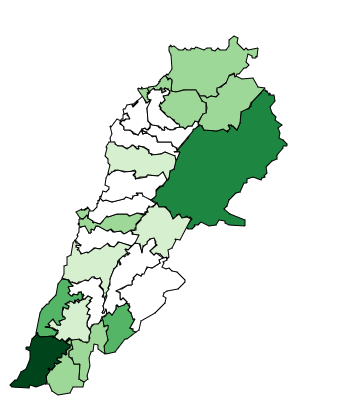
Although the level of conflictivity in Baalbeck declined during the first semester of 2018, it nonetheless remained a hot-spot for Armed Conflicts, with incidents mainly stemming from disputes between rival families that escalated into clashes involving the use of heavy artillery. Similar clashes often erupt in this area between families and clans who are backed by their own militia. Read more
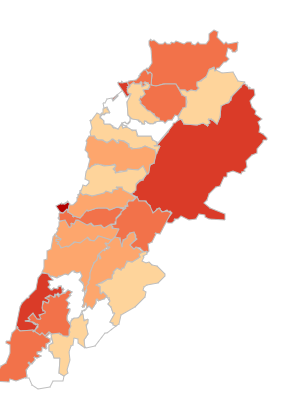
During the first semester of 2018, the Collective Actions have been relatively spread across Lebanon, whereas most were concentrated in specific areas during the last semester of 2017. Ahead of the Parliamentary elections held on May 6th, many collective actions appeared to revolve around pressuring runner-up policy makers throughout the country to address citizens’ concerns on a local level. Read more.
Explore all the Conflictivity Index maps and blurbs for the first half of 2018 here.
عدد 13 كانون الثاني/ يناير 2019
عن النشرة:
إنّ نشرة تحليل النزاعات، وهي جزء من مشروع تحليل النزاعات (Conflict Analysis Project)، هي عبارة عن مبادرة أطلقها مركز دعم لبنان بدعم من برنامج الأمم المتحدة الإنمائي ووضعها على منصة المعرفة خاصّته، أي بوابة المعرفة للمجتمع المدني. تهدف هذه النشرة إلى إتاحة المعلومات والبحوث حول النزاعات في لبنان بغية تحسين فهم أسبابها الكامنة والتأثير في عملية بلورة التدخلات ووضع السياسات.
وتتضمّن هذه النشرة رسومات بيانية تُركِّز على اتجاهات النزاعات الممسوحة خلال ثالث أربع أشهر من السنة. كما أنها تسلط الضوء على مروحة منتقاة من أحدث المطبوعات والمنشورات على صفحة مشروع تحليل النزاعات، بما في ذلك الأوراق، والمقالات، والتقارير، والرسومات البيانية، والمحتوى التفاعلي.
تعريف النزاع:
لا ينظر مركز دعم لبنان إلى العنف من منظور إطار أمني تصاحبه أعمال العنف والعدوانية، بل يتعداه ليتمسّك بموقفه القائل إنّ النزاع هو ذات طبيعة اجتماعية وسياسية. وبالتالي، يضيء المركز على الديناميات التي تحيط بمروحة واسعة من الخلافات العنيفة وغير العنيفة، بما فيها الحركات الإجتماعية مروراً بالنزاعات التي تتورّط فيها الأقليات (الإثنية أو الدينية أو الجنسية من ضمن أخرى)، بالإضافة إلى سياسات الأطراف الفاعلة المحلية أو الوطنية أو الإقليمية. إقرأ المزيد وتصفّح خريطة النزاعات التفاعلية هنا.
الاتجاهات الرئيسية للبيانات في الفترة بين شهري أيلول/ سبتمبر وكانون الأول/ ديسمبر 2018
- شهد الثلث الأخير من العام 2018 ما مجموعه 1093 حادثاً، ما يمثّل زيادةً مقدارها 12 بالمئة مقارنةً بالثلث الثاني من العام عينه، و38 بالمئة بالمقارنة مع الفترة عينها من العام السابق.
- كانت التوقيفات إلى حدٍ بعيد هي حوادث الفئة الأولى الأكثر مسحاً أثناء الثلث الأخير من العام، حيث يندرج ضمن هذه الفئة 529 حادثاً. ارتبط 42 بالمئة من هذه الحوادث بعمليات الإتجار غير المشروع.
- ارتفع عدد الاشتباكات الممسوحة (19 حادثاً) بين شهري تشرين الأول/ أكتوبر وكانون الأول/ ديسمبر بأكثر من ثلاثة أضعاف مقارنةً بالثلث السابق من العام (6 حوادث) بحوادث تضمنت في كثيرٍ من الأحيان استخدام الأسلحة الثقيلة كالمدافع الرشاشة والقنابل اليدوية. حدثت سبعةٌ من هذه الاشتباكات في مخيم المية ومية للاجئين الفلسطينيين الذي شهد تصعيداً في التوترات أثناء الأشهر الأخيرة (انظر الرسم البياني الثالث أدناه). أمّا بقية هذه الاشتباكات، فقد حدثت في منطقة البقاع.
- على الرغم من أنّ عدد الحوادث المصنّفة ضمن فئة أعمال العنف الفردية قد تضاءل قليلاً بين شهري تشرين الأول/ أكتوبر وكانون الأول/ ديسمبر مقارنةً بالثلث الثاني من العام، غير أنّه ظلّ أكثر التصنيفات الأولية الممسوحة ببلوغ عدد الحوادث المدرجة ضمن هذا التصنيف 504 حادثاً.
- ظلّ عدد الحوادث المتعلقة بالنزاعات الحدودية مع سورية (70 حادثاً) ثابتاً مقارنةً بالثلث السابق (69). وتعلق معظمها بتوقيف مواطنين سوريين بسبب الإقامة غير الشرعية أو عبور الحدود بطريقةٍ غير شرعية.
- لمحة عامة عن النزاعات الممسوحة (بين شهري أيلول/ سبتمبر وكانون الأول/ ديسمبر 2018)

- المواقع
شهد الثلث الأخير من العام 2018 ما مجموعه 1093 حادثاُ، ما يمثّل زيادةً مقدارها 12 بالمئة مقارنةً بالثلث الثاني من العام عينه، و38 بالمئة مقارنةً بالفترة عينها من العام السابق. توزّعت الحوادث الممسوحة في أرجاء البلاد بما أنّ الحوادث في الأقضية الخمسة الأكثر مسحاً لم تتجاوز 37 بالمئة من إجمالي الحوادث الممسوحة.
أصبح قضاء صور، الذي لم يصل إلى المركز الثالث إلا في الثلث السابق من العام، الموقع الأكثر مسحاً بـ 110 حادثاً، تلاه قضاء صيدا (110) وبيروت (106) ومرجعيون (68) وبعلبك (64).
في صيدا، صُنّفت غالبية الحوادث (61) في فئة أعمال العنف الفردية وقد تعلق معظمها التوقيفات، والمشاجرات/ الخلافات، وحوادث إطلاق النار، والسرقات، وما شابه. كذلك، كان مخيم عين الحلوة مكان وقوع الحوادث الـ27 الممسوحة في صيدا. إذ يشهد المخيم في كثيرٍ من الأحيان، نتيجةً للأوضاع الاقتصادية الاجتماعية المتردّية، تصاعداً في التوترات بين الفصائل، وكذلك بين اللاجئين. (اقرأ المزيد عن عين الحلوة في نشرة تحليل النزاعات الخاصة بنا، العدد 7 هنا).
صُنّف 67 بالمئة من الحوادث الممسوحة في بيروت في فئة التوقيفات. يشير هذا العدد إلى الحضور الأمني الملحوظ للدولة في العاصمة، وفي المقابل نجد الغياب النسبي لحضورها في الأطراف المحيطة.
أصبح الوضع الأمني في بعلبك أكثر استقراراً في الثلث الأخير من العام بعد أن شهد تدهوراً في الشهور الأخيرة، بما أنّ أعداد الحوادث المذكورة في القضاء انخفضت بصورةٍ ملحوظة بمقدار 57 بالمئة مقارنةً بالثلث السابق (157). وقد عُزي هذا التحسن في الوضع الأمني إلى تكثيف الجيش اللبناني لعملياته في المنطقة وكذلك إلى الجهود التي بذلها الأهالي لاستعادة الأمن. واقع الأمر أنّ العشائر البارزة التي تساندها في كثيرٍ من الأحيان الميليشيات الخاصة بها هيمنت على تلك المنطقة التي أصبحت معقلاً المجرمين والفارين من وجه العدالة نتيجةً لضعفٍ في التنمية وفي سيطرة الدولة. على هذا، وبما يتجاوز المخاوف الأمنية، يمكن اعتبار عمليات الجيش اللبناني الأخيرة في المنطقة محاولةً تقوم بها الدولة لاستعادة سيطرتها عليها واسترداد سلطتها فيها.
- الفئات
كانت التوقيفات هي الفئة الأولى الأكثر مسحاً إلى حدٍ كبيرٍ أثناء الثلث الأخير من العام بما لا يقل عن 529 حادثاً ضمن هذه الفئة. تعلق 42 بالمئة من هذه الحوادث بعمليات الإتجار غير المشروع. فبين شهري تشرين الأول/ أكتوبر وكانون الأول/ ديسمبر من العام 2018، ازداد عدد الحوادث المدرجة في فئة الإتجار غير المشروع (238) بنسبة 22 بالمئة مقارنةً بالثلث الثاني من العام (196). ارتبطت غالبية هذه الحوادث بالمخدرات (168)، في حين ارتبط 19 حادثاً بتهريب البشر و16 بتزييف النقود و14 بتزوير الوثائق. وعلى الرغم من أنّ لبنان يعدّ أحد المنتجين الرئيسيين للحشيش في العالم، إلا أنّ هذه الممارسة لا تزال غير مشروعة في البلد. ومع ذلك تواصلت النقاشات، في سياق الحوارات العامة لشرعنة إنتاج الحشيش لأغراضٍ طبية وتصديره، داخل المجلس النيابي المنتخب حديثاً لاستكشاف مثل هذه الإمكانية. لكن على الرغم من هذا التطور السياسي الجديد بصدد زراعة الحشيش، لا يبدو أنّ السلطات قد قللت من تصميمها على القضاء على تجارة المخدرات في البلد طالما أنّ عدد العمليات المتعلقة بالمخدرات حافظ على تزايده في الثلث الأخير من العام. (اقرأ المزيد عن عمليات الإتجار غير المشروع في نشرة تحليل النزاعات الخاصة بنا، العدد 9، كانون الثاني/ يناير 2018 هنا، وراجع تحليل رد الدولة على الأنشطة غير الشرعية في العام 2015 هنا).
ارتفع عدد الاشتباكات (19) الممسوحة بين شهري تشرين الأول/ أكتوبر وكانون الأول/ ديسمبر بأكثر من ثلاثة أضعاف مقارنةً بالثلث السابق من العام (6) مع حوادث تضمنت في كثيرٍ من الأحيان استخدام الأسلحة الثقيلة كالمدافع الرشاشة والقنابل اليدوية. حدثت سبعة من هذه الاشتباكات في مخيم المية ومية للاجئين الفلسطينيين الذي شهد تصعيداً في التوترات أثناء الشهور الماضية (انظر الرسم البياني الثالث أدناه). أمّا بقية الحوادث، فقد وقعت أساساً في منطقة البقاع ونشبت أثناء عمليات الجيش في المنطقة لتوقيف مجرمين مطلوبين. فعلى سبيل المثال، اندلعت اشتباكاتٌ مسلحة بتاريخ 30 تشرين الثاني/ نوفمبر بين الجيش اللبناني ومجرمين مشهورين فتحوا النار على الدورية أثناء عملية مداهمة، ما أدى إلى وقوع عدة إصابات. (اقرأ المزيد عن حوادث إطلاق النار في نشرة تحليل النزاعات الخاصة بنا، العدد 10، شباط/ فبراير 2018 هنا). في سياق عدم الاستقرار والتوترات الاقتصادية الاجتماعية، أتاح توافر الأسلحة تشكيل ميليشيات مسلحة تعمل خارج سيطرة الدولة. نتيجةً لذلك، غالباً ما تنشب الاشتباكات المسلحة ليس بين أجهزة الدولة الأمنية ومقاتلين مسلحين تسليحاً جيداً فحسب، بل كذلك بين مقاتلين منتسبين لعائلاتٍ وعشائر بارزة.
جرى مسح 38 تحرّكاً في الثلث الأخير من العام. تنوّعت المظالم وارتبط معظمها بالقضايا المتواصلة كالفساد وأزمة إدارة النفايات والقضايا الاقتصادية الاجتماعية. وقد بدا أنّ الإحباط يستشري بين المواطنين في الأشهر الماضية، فمنذ انتخاب مجلسٍ نيابي جديد في أيار/ مايو المنصرم مؤيدٍ للسياسات الطائفية القائمة، تجري عرقلة تشكيل حكومةٍ جديدة بسبب الخصومات السياسية والصراع على السلطة بين الأحزاب السياسية. كلّ هذا يعيق محاولات إصلاح القضايا الاقتصادية الاجتماعية الكبرى في لبنان ومعالجتها، ويضيف ذريعةً التحشيدات المحتملة والتحرّكات المستقبلية.
تزايدت حوادث العنف على أساس النوع الاجتماعي بنسبة 40 بالمئة بين شهري تشرين الأول/ أكتوبر وكانون الأول/ ديسمبر، لاسيما بحوادث تتعلق بالعنف المنزلي والاعتداء الجنسي وكذلك الابتزاز الجنسي. تعرّف المنظمة الدولية للشرطة الجنائية (الإنتربول) الابتزاز الجنسي بأنّه "ابتزازٌ تُستخدم فيه المعلومات أو الصور الجنسية لتحقيق مآرب جنسية و/ أو مالية من الضحية". وقد قامت الشرطة المعنية بالجرائم الإلكترونية وكذلك منظمات المجتمع المدني مثل منظمة تبادل الإعلام الاجتماعي "سمكس" برفع مستوى الوعي تجاه هذه القضية. لكن على الرغم من هذه الجهود، تبقى حالات الابتزاز الجنسي شائعةً في لبنان بسبب الجهل المحيط بالقضية وامتناع الضحايا عن التبليغ بمثل هذه الجرائم.
- الأطراف الفاعلة
بين شهري تشرين الأول/ أكتوبر وكانون الأول/ ديسمبر 2018، أصبحت قوى الأمن الداخلي أكثر الأطراف الفاعلة مسحاً بضلوعها في 375 حادثاً، على الرغم من أنّها احتلت المرتبة الثالثة من بين الأطراف الفاعلة الأكثر مسحاً في الثلث السابق (243 حادثاً). تشير هذه الزيادة الملحوظة إلى موقفٍ استباقي من أجهزة الأمن الحكومية لاحتواء الجريمة في الفترة المذكورة (انظر أعلاه). احتل المدنيون اللبنانيون المرتبة الثانية من الأطراف الفاعلة الأكثر مسحاً بضلوعهم في 370 حادثاً، يليهم المدنيون/ اللاجئون السوريون بـ 221 حادثاً، ما يمثّل زيادةً بنسبة 16 بالمئة مقارنةً بالثلث الثاني من العام (190). تعلقت هذه الحوادث بصورةٍ أساسية بتوقيف المواطنين السوريين بسبب الإقامة غير الشرعية أو بسبب ارتكاب مخالفاتٍ مثل التزوير، الإتجار غير المشروع، السرقة، وما شابه.
من الجدير بالملاحظة في هذا السياق أنّ السياسات التقييدية التي اعتمدتها الدولة اللبنانية منذ تشرين الأول/ أكتوبر 2014 من أجل ضبط الوجود السوري في لبنان قد ساهمت في زيادة الأنشطة غير الرسمية بين اللاجئين السوريين وكذلك في أعداد اللاجئين الذين تنقصهم الوثائق القانونية، جاعلةً إياهم أكثر عُرضةً لمخاطر التوقيف والاحتجاز. بإمكانكم قراءة مزيدٍ من البحث المعمق حول هذا الموضوع هنا.
كان عدد الحوادث التي كان مدنيون/ لاجئون فلسطينيون ضالعين فيها (77 حادثاً)، وهو عددٌ يتماشى مع ميول الثلث السابق من العام (71 حادثاً) ووقعت بصورةٍ رئيسيةٍ في مخيمي عين الحلوة والمية ومية للاجئين الفلسطينيين. ومن الجدير بالذكر أنّه حتى لو كان عدد الحوادث التي كان الفلسطينيون ضالعين فيها قد ظلّ ثابتاً، غير أنّ مدى مثل هذه النزاعات كان أكثر أهميةً أثناء الشهور الأربعة الأخيرة من العام 2018، مع اندلاع اشتباكاتٍ مسلحة، لاسيما في مخيم المية ومية (لمزيدٍ من المعلومات حول الاشتباكات في المخيمات الفلسطينية، انظر الرسم البياني الثالث أدناه).
2. تواتر النزاعات بحسب التصنيف الأولي للزاع (أيلول/ سبتمبر ـ كانون الأول/ديسمبر 2018)

على الرغم من أنّ عدد الحوادث المصنّفة بأنها أعمال عنفٍ فردية تضاءل قليلاً بين شهري تشرين الأول/ أكتوبر وكانون الأول/ ديسمبر مقارنةً بالثلث الثاني من العام، غير أنّها ظلّت التصنيف الأولي الأكثر مسحاً بـ504 حادثاً تندرج ضمن هذا التصنيف. علاوةً على ذلك، صُنّف 203 حادثاً في فئة النزاعات على السلطة والحكم، ما يتماشى مع ميل الثلث السابق (199 حادثاً). يشير هذا العدد إلى أنّه على الرغم من أنّ لبنان شهد دوراتٍ متكررة من العنف والتوترات في الأعوام السابقة تتضمّن اشتباكاتٍ وموجاتٍ من التفجيرات الانتحارية والهجمات الإرهابية والتوترات السياسية من بين تهديداتٍ أخرى لسلطة الدولة المركزية، فقد ظلت غالبية الحوادث الأمنية المبلّغ عنها في البلد متعلقةً بالجريمة وانتهاكات القانون بين المواطنين كالخلافات وحوادث إطلاق النار والاعتداءات وما شابه. من المرجح أنّ ركود الوضع الاقتصادي الاجتماعي قد ساهم في المستويات الأعلى من الجريمة وانتهاكات القانون طالما أنّ عدم المساواة لا تزال مرتفعة.
ظلّ عدد الحوادث المتعلقة بالنزاعات الحدودية مع سوريا (70 حادثاً) ثابتاً مقارنةً بالثلث السابق (69 حادثاً). يقع معظم هذه الحوادث ضمن الحدود اللبنانية السورية في مرجعيون وحاصبيا. ويرتبط معظمها بتوقيف مواطنين سوريين بسبب الإقامة غير الشرعية أو بسبب عبور الحدود بطريقةٍ غير شرعية. على سبيل المثال، قام الجيش اللبناني بتاريخ 27 أيلول/ سبتمبر بتوقيف أكثر من 200 مواطنٍ سوري في بلدة الصويري عندما حاولوا دخول لبنان بطريقةٍ غير شرعية. جرى تبادل إطلاق النار خلال هذه العملية بين المهربين والجيش، ما أسفر عن أربع إصابات في صفوف اللاجئين.
علاوةً على ذلك، كان لثلاثٍ من هذه الحوادث طابع إجرامي، وتم تصنيفها بالتالي ضمن فئة النزاعات المرتبطة بالتمييز الاجتماعي، إذ قام الجيش بعمليات مداهمةٍ لمخيمات اللاجئين السوريين. وعلى الرغم من أنّ هذه العمليات استهدفت أساساً أشخاصاً مطلوبين التجأوا إلى المخيمات، إلا أنّ المطاف ينتهي عادةً بالجيش إلى توقيف عددٍ معتبرٍ من اللاجئين الذين لا يمتلكون وثائق قانونية. على سبيل المثال، قام الجيش اللبناني بتاريخ 29 تشرين الأول/ أكتوبر بتوقيف 121 لاجئاً خلال مداهمة مخيمٍ في عرسال، لم تكن توجد مذكرات سارية إلا بحق 21 منهم. وقد أدى هذا إلى تشكيك كثيرين بالهدف الكامن وراء عمليات المداهمة هذه.
تم مسح 15 حادثاً من فئة النزاعات المرتبطة بالتمييز الاجتماعي في هذه الفترة، أربعٌ منها يصنّف ضمن فئة العنف على أساس النوع الاجتماعي، وذلك عندما قامت السلطات بتفكيك شبكات دعارة. فعلى سبيل المثال، قامت قوى الأمن الداخلي بتاريخ 18 تشرين الأول/ أكتوبر بتوقيف أربعة أعضاء من مجموعةٍ تتاجر بالأشخاص لأغراض الاستغلال الجنسي في مرجعيون. وغالبية الحوادث المرتبطة بالدعارة تورّطت فيها سوريات أُكرهن في أغلب الأحيان على هذه الممارسة، وكنّ أكثر عُرضةً للمخاطر وتعرّضن للاستغلال الجنسي لأنهنّ لم يحصلن في كثيرٍ من الأحيان على الإقامة الشرعية، ما يجعلهنّ متردداتٍ في التبليغ عن جرائم كهذه (لمزيدٍ من التفاصيل حول الحوادث المتعلقة بالعنف على أساس النوع الاجتماعي، انظر تقريرنا حول سبل عيش اللاجئين السوريين هنا واقرأ نشرة تحليل النزاعات، العدد 11، أيار/ مايو 2018 هنا).
بين شهري تشرين الأول/ أكتوبر وكانون الأول/ ديسمبر، تم تصنيف 10 حوادث في فئة النزاعات المرتبطة بالتنمية الاقتصادية الاجتماعية وارتبط معظمها بتحرّكاتٍ نظّمتها ليس مجموعات غير رسمية من مواطنين يشجبون الوضع الاقتصادي المتقلقل في البلد فحسب، بل كذلك فئاتٌ من العاملين في القطاع العام احتشدت لأعوامٍ من أجل تحسين وضعها الاقتصادي الاجتماعي. فعلى سبيل المثال، احتشد معلمو المدارس الرسمية على الأقل منذ العام 2011 مطالبين برفع مستوى أجورهم. غير أنّ المناقشات لرفع أجورهم تبدو حالياً في طريقٍ مسدود. وعلى الرغم من أنّ الانتخابات التي أسفرت عن مجلسٍ نيابي جديد في 6 أيار/ مايو، فقد عجزت الدولة عن معالجة مطالب المواطنين، ما أدى إلى تصاعد عمليات التحشيد في الأشهر الأخيرة من هذا العام. ويبدو أنّ الأمل في أنّ انتخاب مجلسٍ نيابي جديد سيحسن الوضع الاقتصادي الاجتماعي في البلد قد تبدد بين المواطنين الذين نزلوا إلى الشوارع للضغط على السلطات من أجل معالجة شواغلهم قبل نهاية العام. تحلل ورقة بحثٍ نشرها مؤخراً مركز دعم لبنان ضمن مجلة المجتمع المدني حدود الحركة العمالية وتأثيرها المحدود على الإصلاح.
3. إضاءة على الحوادث في مخيمات اللاجئين الفلسطينيين في لبنان

في الوقت الحالي، هنالك 12 مخيماً للاجئين الفلسطينيين تستضيف قرابة نصف مليون لاجئ مسجل وفق وكالة الأمم المتحدة لغوث وتشغيل اللاجئين الفلسطينيين (الأنوروا).
وعلى الرغم من تواتر النزاعات في هذه المخيمات في العقود السابقة، بفتراتٍ متناوبة من العنف والهدوء النسبي، إلا أنّ الشهور الأربعة المنصرمة من العام شهدت تصاعداً في التوترات. واقع الحال أنّ 52 حادثاً تم مسحها في مخيمات اللاجئين الفلسطينيين في أرجاء لبنان في غضون أربعة شهورٍ فحسب. صنّفت سبعة حوادث منها ضمن فئة الاشتباكات المسلحة بين الفصائل الفلسطينية وتم مسحها في مخيم المية ومية. يقع هذا المخيم في صيدا ويستضيف 5000 لاجئ مسجل. بتاريخ 16 تشرين الأول/ أكتوبر، اندلع اشتباكٌ في المخيم في أعقاب منازعة بين أعضاء حركة فتح وحركة أنصار الله. سرعان ما تصاعد الشجار إلى نزاعٍ مسلحٍ بين الفصيلين دام لأكثر من أسبوع واستُخدمت فيه الأسلحة الآلية والقنابل اليدوية وأسلحة ثقيلة أخرى.
هنالك أكثر من 17 فصيلاً تعمل في المخيمات معظمها مسلحٌ بشكلٍ فعال، ما يفضي إلى نشوب نزاعاتٍ مسلحة بين حينٍ وآخر.
غير أنّ نَسب عدم الاستقرار الأمني في هذه المخيمات لوجود الفصائل المسلحة اختزاليٌ تماماً، بما أنّ نشوب النزاعات لا يرتبط حصراً بتصاعد التوترات بين جماعات المقاتلين المسلحة فحسب، بل كذلك بتصاعد العنف عموماً. وبالفعل، فإنّ الوضع الاقتصادي الاجتماعي في المخيمات متردٍّ بشدة مع سوء السكن والخدمات، وفقدان البنية التحتية والبطالة من بين مسائل أخرى. تفاقم هذا الوضع مع تدفق الفلسطينيين الفارين من الحرب السورية إلى مخيماتٍ ذات قدرةٍ محدودةٍ أصلاً على الوصول إلى الموارد. وعلى هذا، غالباً ما تفضي ضغوط الحياة الدائمة التي يتعرض لها اللاجئون إلى اندلاع العنف. يتماشى هذا مع ميول البيانات، بما أنّ غالبية هذه الحوادث الممسوحة داخل مخيمات اللاجئين الفلسطينيين صُنّفت ضمن فئة أعمال العنف الفردية (33 حادثاً)، يتصل معظمها بحوادث إطلاق النار والمشاجرات وأنشطة الإتجار غير المشروع، وما شابه.
وبهدف تحسين هذه الشروط المعيشية، قامت الأونروا منذ تشكيلها في العام 1949 بتقديم الدعم والمساعدات التنموية للسكان الفلسطينيين، ومن ضمنها الرعاية الصحية والتعليم وخدمات اجتماعية أخرى. غير أنّ الوكالة واجهت في الشهور الماضية "أكبر أزماتها المالية". فبتاريخ 31 آب/ أغسطس، أعلنت الولايات المتحدة قرارها بإيقافها كافة التبرعات التي تقدمها للوكالة، بعد عدة شهورٍ من بدء تخفيض مساهماتها المالية. وطالما أنّ الولايات المتحدة كانت تمثّل المساهم الأكبر في الوكالة، فقد أحدث القرار عواقب مهمة على عمليات الأونروا. وعلى هذا، يخشى كثيرٌ من الخبراء من العواقب الإنسانية التي تترتب عن مثل هذه الأزمة على السكان الفلسطينيين الذين يعتمدون اعتماداً كبيراً على مساعدة الوكالة. وبالفعل، ربما تعرّض هذه الأزمة الشروط المعيشية المتردية أصلاً للتدهور، جاعلةً المخيمات عرضةً لمزيدٍ من مخاطر اندلاع العنف والنزاعات.
4. المسح المبرز ضمن مشروع تحليل النزاعات
خرائط مؤشر الحالة النزاعية للنصف الأول من العام 2018

على الرغم من أنّ مستوى الحالة النزاعية في بعلبك انخفض في النصف الأول من العام 2018، بيد أنّه ظلّ بقعةً ساخنة للنزاعات المسلحة، بحوادث نجم أغلبها عن منازعاتٍ بين العائلات المتنافسة، تصاعدت لتتحول إلى اشتباكاتٍ تتضمن استخدام الأسلحة الثقيلة. غالباً ما تندلع اشتباكاتٌ مماثلة في هذه المنطقة بين عائلاتٍ وعشائر تدعمها ميليشياتها الخاصة. اقرأ المزيد

انتشرت التحرّكات نسبياً في أرجاء لبنان أثناء النصف الأول من العام 2018، بينما تركز معظمها في مناطق بعينها أثناء النصف الأخير من العام 2017. ظهر كثيرٌ من التحرّكات قبل الانتخابات النيابية التي انعقدت بتاريخ 6 أيار/ مايو لممارسة الضغوط على صناع السياسة المتنافسين في كافة ارجاء البلاد من أجل معالجة شواغل المواطنين على المستوى المحلي. اقرأ المزيد
استكشف كافة خرائط مؤشر الحالة النزاعية وتعريفاتها للنصف الأول من العام 2018 هنا.

